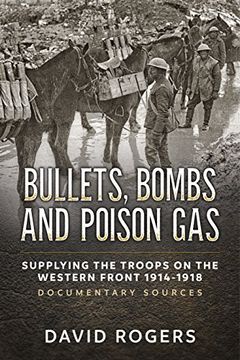Share
Bullets, Bombs and Poison Gas: Supplying the Troops on the Western Front 1914-1918, Documentary Sources (in English)
David Rogers
(Author)
·
Helion & Company
· Paperback
Bullets, Bombs and Poison Gas: Supplying the Troops on the Western Front 1914-1918, Documentary Sources (in English) - Rogers, David
$ 18.57
$ 26.53
You save: $ 7.96
Choose the list to add your product or create one New List
✓ Product added successfully to the Wishlist.
Go to My Wishlists
It will be shipped from our warehouse between
Monday, June 10 and
Wednesday, June 12.
You will receive it anywhere in United States between 1 and 3 business days after shipment.
Synopsis "Bullets, Bombs and Poison Gas: Supplying the Troops on the Western Front 1914-1918, Documentary Sources (in English)"
Soldiers in the trenches were issued with four bullets a day unless they were either snipers or manned a machine gun. This does not seem like a lot of bullets. However, four bullets a day is 28 per week. Therefore a million soldiers need 28 million bullets per week. Of course there were a lot more than a million troops at the Western Front, so the number of required bullets was more than that! I realise that some of the soldiers performed vital service functions and some were busy on other duties, nevertheless there was a need for a lot of bullets. Supplying the troops was further complicated by the need to ensure that the many and varied shells were available for the howitzers, mortars and other artillery. Furthermore, there was a need for essential supplies of a whole manner of other materials, including rations for the troops and food for the many horses. Aircraft and tanks also started to make an appearance on the battlefield at this time which required supplies. Indeed there is one account of a horse drawn cart carrying aircraft fuel to the aeroplanes! The move to modern technology must have been interesting to watch. The static nature of battle was somewhat unique in the annals of warfare and led to the use of a narrow gauge railway network and a roll on roll off ferry port in Kent to speed deliveries along. Unfortunately, not all of the traffic was towards the trenches. Sadly there were many casualties who needed to return to the hospitals either in the field or back in Britain. The returning trains performed this vital function. Servicing this supply chain was a complex business, leading to some interesting issues.
- 0% (0)
- 0% (0)
- 0% (0)
- 0% (0)
- 0% (0)
All books in our catalog are Original.
The book is written in English.
The binding of this edition is Paperback.
✓ Producto agregado correctamente al carro, Ir a Pagar.

